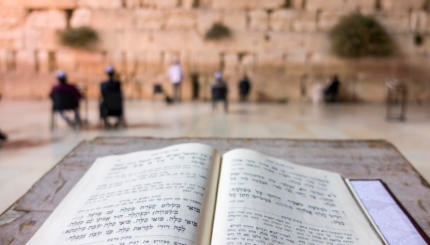Rabbi Elie Kaunfer is the author of Empowered Judaism: What Independent Minyanim Can Teach Us about Building Vibrant Jewish Communities. He’ll be blogging all week for Jewish Book Council and MyJewishLearning’s Authors Blog series.
It’s strange to write a book about independent minyanim when you don’t even attend one anymore.
Independent minyanim are those grassroots, all-volunteer-led Jewish prayer communities that have popped up with force across the United States, Israel and Europe over the past decade. In 2000 there were three of them; now there are more than 70. I wrote about them in
Empowered Judaism: What Independent Minyanim Can Teach Us about Building Vibrant Jewish Communities
.
For eight years, since I co-founded Kehilat Hadar -– one of the flagship independent minyanim –- in 2001, the minyan was my Jewish community and spiritual home. Even after I retired from the leadership in 2005, I would attend the minyan’s services and learning programs, watching the community grow and mature.
Then I fell victim to a force much more powerful than upstart Jewish community: New York City real estate prices. My wife and I had a daughter a couple of years ago, and all of a sudden, our cozy 1-bedroom apartment on 110th Street transformed into a nightmare of space needs. We couldn’t afford a bigger place on the Upper West Side. So we did what Jews have done for centuries: we migrated.
Shunning the obvious next-step neighborhoods like Park Slope or Riverdale, we moved up to Washington Heights. We even recruited people to join us. But we didn’t start an independent minyan. Instead, we joined a synagogue.
The synagogue is by no means cutting-edge. It was founded in 1938. It has an old-school name: The Fort Tryon Jewish Center. It uses a siddur that was published in 1960. There is a ritual committee, a board and membership dues.
And yet, it’s not your average synagogue either. It never affiliated with a denomination, and prides itself on being independent. Laypeople read the Torah and lead the prayers. It is multigenerational, with people in their 80s schmoozing with people in their 20s (many of whom are students at Kehilat Hadar’s affiliated Yeshivat Hadar) at kiddush. They have hot cholent and hot veggie stew for the non-meat-eaters.
The synagogue hired a young rabbi last year named Micha’el Rosenberg; he received Orthodox ordination in Israel but believes in equal participation for men and women. (When he lived on the Upper West Side, he used to daven at Kehilat Hadar). Taking a page out of the independent minyanim playbook, he only speaks for 5 minutes.
The synagogue isn’t perfect. In fact, its main challenge is space. It meets in the social hall of another synagogue, and the room is simply too big for the number of people who come. It’s hard to build religious energy with 60 people in a room built for 400. But every week there are new faces, and the community is certainly gaining momentum.
So what does it mean that one of the chief champions of independent minyanim is a member at a synagogue? It demonstrates that the whole independent minyan phenomenon was never an either-or proposition between minyanim and synagogues. People are looking for Jewish community that works. If it’s in a synagogue, they will happily join a synagogue. It also shows that synagogues are being influenced by independent minyanim. When the rabbi knows the ethos of independent minyanim from the inside, s/he is unafraid to borrow tactics that worked there for use in the synagogue.
The future of Jewish community is not limited to independent minyanim or synagogues. In the ideal, both minyanim and synagogues will learn from each other, and we will see a variety of models for engaged Jewish life.
Rabbi Elie Kaunfer, the author of Empowered Judaism: What Independent Minyanim Can Teach Us about Building Vibrant Jewish Communities, is blogging all week in Jewish Book Council and MyJewishLearning’s Authors Blog series.
daven
Pronounced: DAH-vun, Origin: Yiddish, to pray, following the Jewish liturgy.
minyan
Pronounced: MIN-yun, meen-YAHN, Origin: Hebrew, quorum of 10 adult Jews (traditionally Jewish men) necessary for reciting many prayers.

